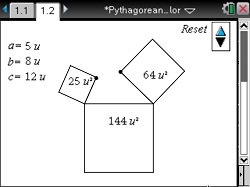Pythagorean Relationships

Pythagorean Relationships
Investigate the triangles that can be formed using one side of three squares to build the triangle.
- Students will determine that a right triangle exists when the sum of the areas of the squares built on the short sides is equal to the area of the square built on the longest side.
- Pythagorean Theorem
- converse
- acute triangle
- right triangle
- obtuse triangle
This activity allows students to experiment with three squares to see if they can make a triangle using one side of each square. They are then asked to classify the triangles and conjecture about the relationships between the areas of the three squares that produced acute, right, and obtuse triangles. This activity is a geometric visualization of the Pythagorean relationship: if the sum of the areas of the two small squares is equal to the area of the large square, then the triangle formed by one side of each square will be right.
Vernier EasyData,Vernier EasyLink and Vernier EasyTemp are registered trademarks of Vernier Science Education.

